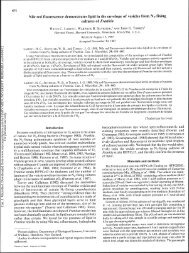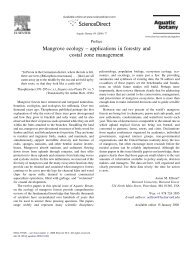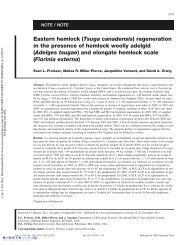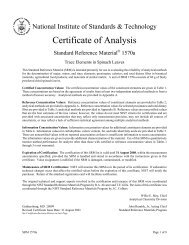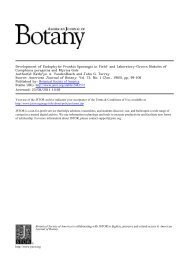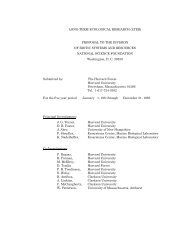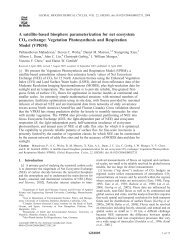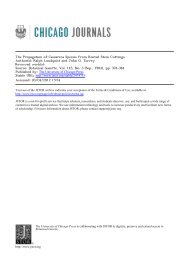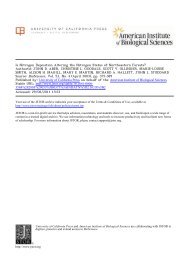Abstracts of Papers - Harvard Forest - Harvard University
Abstracts of Papers - Harvard Forest - Harvard University
Abstracts of Papers - Harvard Forest - Harvard University
You also want an ePaper? Increase the reach of your titles
YUMPU automatically turns print PDFs into web optimized ePapers that Google loves.
infected with vascular pathogens appear adjacent to<br />
vein endings. Terminating vessel members in leaves<br />
may be sites <strong>of</strong> accumulation <strong>of</strong> pathogen metabolites,<br />
degraded cell wall components or wound reactants.<br />
Anatomical studies <strong>of</strong> these terminal vessel members<br />
has provided scant evidence for their importance in<br />
vascular wilt disease and has centered on phylogenetic<br />
comparisons <strong>of</strong> terminating vessels. Our study there-<br />
fore was aimed at a detailed anatomical appraisal <strong>of</strong><br />
terminating vessels especially the structure <strong>of</strong> end<br />
walls. Leaves <strong>of</strong> tomato, chrysanthemum, alfalfa and<br />
hop were prepared for electron microscopy and serially<br />
sectioned from the tip. Tips <strong>of</strong> all terminal tracheids<br />
narrowed rapidly towards the ends and no perforation<br />
plates were observed. Tracheids ended either singly<br />
in chrysanthemum, tomato and hop or in pairs in alfalfa.<br />
Chrysanthemum and alfalfa endings were closely ad-<br />
pressed to parenchyma cells with little discernable<br />
distinction between the walls <strong>of</strong> both cells. This<br />
intimate association suggested a free transfer <strong>of</strong><br />
xylem fluids through walls in the symplast. Tomato<br />
and hop endings were positioned in areas <strong>of</strong> less<br />
coherence being surrounded by many intercellular<br />
spaces. All the tracheid tipswere triangular in cross-<br />
section and extensively thickened. The endings con-<br />
tained many pit surfaces and in chrysanthemum there<br />
was a characteristic tail which appeared to be composed<br />
<strong>of</strong> secondary thickened laminar fibres. Extensive<br />
accumulation <strong>of</strong> granular phenolics in the lumens <strong>of</strong><br />
some tracheid tips suggested that this area was<br />
particularly susceptible to aggregations <strong>of</strong> plant and<br />
fungal metabolites which might contribute towards<br />
water flow restriction to leaf mesophyll cells and<br />
ensuing vascular wilt symptoms.<br />
TUCKER, SHIRLEY C. Department <strong>of</strong> Botany,<br />
Louisiana State <strong>University</strong>, Baton Rouge, LA<br />
70803<br />
- Character weighting in Leguminosae based on<br />
time <strong>of</strong> initiation.<br />
Unifying ordinal or familial characteristics are by<br />
definition stable. These features should therefore<br />
be determined early in floral ontogeny, while those<br />
characteristics which separate related species<br />
should occur relatively late in ontogeny. Examples<br />
<strong>of</strong> early-determined features (to be illustrated with<br />
examples from Leguminosae) include floral symmetry,<br />
order <strong>of</strong> appendage initiation, number and kinds <strong>of</strong><br />
whorls, number <strong>of</strong> parts per whorl, and order <strong>of</strong><br />
initiation within a whorl. A second assemblage <strong>of</strong><br />
characteristics is determined in mid-development<br />
stages; these include corolla aestivation, organ<br />
abortion to produce "loss", elongation <strong>of</strong> some parts,<br />
tube formation <strong>of</strong> calyx, corolla, and androecium,<br />
petal fusion, differential growth <strong>of</strong> petals, differ-<br />
ential growth <strong>of</strong> the two stamen whorls, and forma-<br />
tion <strong>of</strong> gynophore and staminodes. Some <strong>of</strong> these<br />
mid-development-determined characteristics are im-<br />
portant in producing supra-generic distinctions,<br />
while others are more important at the generic level.<br />
Late-determined characteristics, which are likely to<br />
distinguish related species or sometimes genera,<br />
include differential changes in petal shape, petal<br />
color, filament elongation, nectaries, nectar and<br />
fragrance, epidermal elaborations (hairs, sculp-<br />
turing, hooks, pits, cuticle), and changes in carpel<br />
shape. Although exceptions abound to these gen-<br />
eralizations, the hypothesis <strong>of</strong>fers a useful ap-<br />
proach to re-examining and evaluating diagnostic<br />
characteristics in the light <strong>of</strong> their ontogenetic<br />
origin.<br />
Developmental and Structural Section 33<br />
TUCKER, SHIRLEY C. Department <strong>of</strong> Botany,<br />
Louisiana State <strong>University</strong>, Baton Rouge, LA<br />
70803<br />
- Developmental origins <strong>of</strong> petal aestivation in<br />
Cadia purpurea and other legumes.<br />
Although petal aestivation is used to separate sub-<br />
families and some tribes <strong>of</strong> legumes, there is little<br />
developmental evidence on its control in these<br />
groups. Valvate aestivation typifies Mimosoideae,<br />
ascending cochlear aestivation typifies Caesal-<br />
pinioideae, and descending cochlear typifies Papi-<br />
lionoideae. Petals are widely spaced and not imbri-<br />
cate at initiation, nor do the bases extend margi-<br />
nally to become imbricate. Overlapping occurs at<br />
the margins about halfway up the petals when they<br />
are about 300 pm high. Features which determine<br />
which petal overlaps outside another include rela-<br />
tive size, thickness, and degree <strong>of</strong> curvature <strong>of</strong> the<br />
petal in transsection. Petals which overlap have<br />
relatively attenuate margins, while those which ap-<br />
press and fuse have thick, blunt margins. Cadia<br />
purpurea, in the primitive papilionoid tribe Sopho-<br />
reae, appears intermediate to the Caesalpinioideae<br />
because <strong>of</strong> its highly variable petal aestivation.<br />
Ascending cochlear and descending cochlear patterns<br />
are both common among flowers on the same plant.<br />
Also, two patterns occur which are rare in the le-<br />
gumes: 1) a pattern in which the standard petal is<br />
half inside, half outside the wings, and 2) com-<br />
pletely quincuncial. Developmentally, Cadia's petal<br />
enlargement is delayed greatly, compared to other<br />
taxa. All the petals remain the same size and shape<br />
throughout development. When the petals finally<br />
approach one another, the pattern <strong>of</strong> overlap appears<br />
to be a matter <strong>of</strong> chance, unlike the pattern in most<br />
legumes.<br />
VERBEKE, JUDITH and DAN B. WALKER. Department<br />
<strong>of</strong> Biology, UCLA, Los Angeles, CA 90024<br />
- Characterization <strong>of</strong> the mechanism underlying<br />
induced epidermal dedifferentiation in the fusing<br />
carpels <strong>of</strong> Catharanthus roseus.<br />
In the process <strong>of</strong> floral ontogeny in Catharanthus<br />
roseus approximately 400 epidermal cells are induced<br />
to dedifferentiate during the postgenital fusion <strong>of</strong><br />
the two carpel primordia. Previously reported ex-<br />
periments involving the placement <strong>of</strong> gold foil<br />
barriers between prefusion carpels have showm that<br />
dedifferentiation occurred only at points <strong>of</strong> direct<br />
cell-to-cell contact. The morphogenetic stimulus in<br />
this system may, therefore, consist <strong>of</strong> either a<br />
diffusible messenger molecule or some kind <strong>of</strong> cell<br />
surface interaction. To characterize the mechanics<br />
<strong>of</strong> the induction <strong>of</strong> dedifferentiation we placed<br />
barriers <strong>of</strong> various types between the pre-fusion<br />
adaxial surfaces and monitored epidermal develop-<br />
ment as the carpel faces grew into contact. Plastic<br />
barriers (which permitted the diffusion Of 02 and<br />
CO2 but which prohibited the diffusion <strong>of</strong> water)<br />
blocked dedifferentiation <strong>of</strong> the contacting epider-<br />
mal cells, giving a response similar to that pre-<br />
viously reported with the gold foil barriers.<br />
Polycarbonate membranes <strong>of</strong> knowm porosity which can<br />
allow for passage <strong>of</strong> water soluble agents did not<br />
block dedifferentiation <strong>of</strong> the contacting epidermal<br />
cells. Thus, it appears that a diffusible agent is<br />
involved in an intercellular communication that<br />
triggers the dedifferentiation response. Current<br />
efforts are aimed at better characterizing the<br />
agent(s) .




